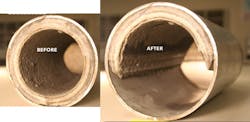Creative Conserving: Exploring Innovative Sustainability Practices in the Pulp & Paper Industry
By Jeff Gunderson
According to the U.S. Environmental Protection Agency (EPA), the paper industry is the single largest user per ton of product of industrial process water in the United States. With water required in virtually every major process phase -- not to mention process cooling, equipment cleaning and other areas -- pulp and paper operations are dependent on abundant supplies of raw water and generate substantial volumes of wastewater.
Despite its hefty water requirements however, pulp and paper manufacturing actually consumes only a relatively small amount. Results from a study conducted by the National Council for Air and Stream Improvement found that 88 percent of the water used in the U.S. forest products industry is returned directly to surface waters following treatment. Still, because pulp and paper is such a water-intensive industry, and taking into account today's pressing issues associated with water scarcity and increasingly tighter water discharge regulations, some of the most significant trends in pulp and paper are inextricably linked to the industry's high water usage.
According to a brief prepared by Sappi Fine Paper North America examining water use and treatment in the pulp and paper industry, the sector has long managed water in the context of a regulatory environment, but now the industry is collectively moving beyond water quality to better understanding quantity and the environmental impacts of water use. With water scarcity becoming a growing concern that will influence water resource management, Sappi stated that an increasing number of companies are developing tools to identify and manage business risks related to water.
Advanced Treatment
In a recent 2013 analysis, Frost & Sullivan found that rising water prices coupled with the pulp and paper industry's high water footprint is forcing manufacturers to adopt water-efficient and high-end equipment to treat wastewater and lower water use. With an increased focus on water recycling, biogas generation and sludge management, strong continued investments in efficient water and wastewater solutions are anticipated in the years to come.
"Although the industry has made great strides in terms of reusing wastewater and recycling process water at different stages, the sheer water volume requirements are still very high," said Eric Meliton, an energy and environmental industry analyst with Frost & Sullivan. "The challenge with pulp and paper is that there are so many processing steps to the various end products, creating large quantities of contaminated process water that need to be managed and treated."
Frost & Sullivan's analysis found an increasing dependence on water specialists for complying with tightening environmental standards, and pulp and paper manufacturers are switching from conventional treatment systems to more sophisticated solutions such as membranes to increase treatment levels and reduce the loss of raw materials. Closed-loop systems were determined to be especially popular as they enable the recycling and reuse of water while also recovering excess pulp fibers from wastewater.
The Influence of Sustainability
Initiatives in corporate sustainability that embrace environmentally-conscious practices are also influential in driving greater adoption of more responsible and efficient water management among pulp and paper companies.
"We are really starting to see more demand emerging from both retailers and consumers for products that are manufactured in a sustainable way," said Meliton. "This represents something that is actively changing -- companies are responding to consumer sentiment, which in turn is having a positive impact on manufacturing practices. The end-user value chain has a lot of influence in this segment, especially in North America."
An overarching example of how sustainability is shaping manufacturing practices in the industry is the American Forest & Paper Association's (AF&PA) Better Practices, Better Planet 2020, a sustainability initiative that embraces a shared commitment among members towards meeting a collection of quantifiable goals. Of these is a goal to reduce water use in members' pulp and paper mills by 12 percent from 2005 to 2020.
Jerry Schwartz, AF&PA senior director of energy and environmental policy, said advances in treatment technologies and a higher focus on water recycling innovations have enabled water to be reused at least 10 times in mill processes before being discharged, significantly reducing the amount of raw water that is withdrawn for production purposes.
"When developing our program, our members made it very clear that they wanted goals that were based on economic, social and environmental principles of sustainability," Schwartz said. "In this regard, the goal to reduce water use made a lot of sense because, on a site-specific basis, the economic rewards can be interwoven with the environmental and social benefits."
Multi-beneficial Solutions
A similar- minded approach to the AF&PA's three-pronged goal framework is also evident in some of the more innovative water-related projects that strive for more than one beneficial result.
"One of the biggest challenges for sustainably-focused projects in pulp and paper is that profit margins can be so thin," said Jeremy Holland, Oregon industrial market sector lead with HDR. "It can be a struggle for facilities to rationalize the benefits of water reuse or water conservation projects when they have so many other competing capital demands. But if solutions are provided that offer multiple benefits, facilities will see these options as easier to justify from a financial perspective."
Water reuse projects that also recover heat in the process are attractive in this sense because of the water savings and reduced energy demands for process water heating, according to Holland.
Another unique example includes a pilot study led by HDR that examines the feasibility of thermal aquifer storage and recovery for a pulp and paper manufacturer. The pilot involves extracting river water during the winter, when flows are at their highest, and injecting that water into a well for later use as a cooling-water source during the summer.
"The well water will have a more optimal temperature for use in cooling as compared to the warmer, summertime river water," Holland said. "This also allows facilities to use less water in their cooling processes because they are able to take advantage of the temperature differential when it is most essential. Additionally, there is also a real environmental benefit in terms of a reduced thermal discharge load, resulting in less thermal impacts to the river in the summer."
Issues with Scaling
A consequence of heavy process water use in pulp and paper manufacturing and an ongoing challenge for many pulp and paper mills is the accumulation of scale -- mineral deposits from water that can plug and corrode equipment, restrict flows, reduce efficiencies, and lead to even greater operational problems including downtime and equipment failure.
"Scale buildup can occur very quickly in pulp and paper operations and wherever water is used in manufacturing for heating and cooling processes," said Tim Fregeau, sales manager at Apex Engineering Products. "The degree of scaling can be attributed to the volume of water use, hardness of the raw-water source and operational temperatures."
Left untreated, mineral deposits can be particularly detrimental to heat transfer systems, according to Fregeau. "Water scale acts like an insulating barrier, impeding heat transfer and forcing the equipment to work harder," he said. "It only takes a thin layer of scale for the economies of power consumption to jump considerably -- just a 16th of an inch of scale equates to an approximate 30-percent loss in efficiency."
Under-deposit corrosion is another potential issue to deal with. "Scale can damage the base alloys that the equipment is made of, compromising the integrity of the systems," Fregeau said.
For resolving the negative effects of water scale in pulp and paper manufacturing, Apex Engineering Products offers RYDLYME, a biodegradable liquid descaling solution that is specifically designed to safely dissolve water scale, lime, mud, and rust deposits from virtually any piece of water-operated equipment.
About the Author: Jeff Gunderson is a correspondent for Industrial WaterWorld. He is a professional writer with over 10 years of experience, specializing in areas connected to water, environment and building, including wastewater, stormwater, infrastructure, natural resources, and sustainable design. He holds a master's degree in environmental science and engineering from the Colorado School of Mines and a bachelor's degree in general science from the University of Oregon.



